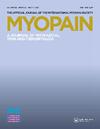Effects of Ankle Dorsiflexion on Vastus Medialis Oblique and Vastus Lateralis Muscle Activity During Straight Leg Raise Exercise with Hip External Rotation in Patellofemoral Pain Syndrome
引用次数: 6
Abstract
Abstract Objectives: The purpose of this study was to investigate the effect of combined ankle dorsiflexion [DF] and straight leg raise with hip external rotation [SLRER] on the vastus medialis oblique [VMO] and vastus lateralis [VL] muscle activity and VMO/VL ratio in subjects with patellofemoral pain syndrome [PFPS] and healthy normal control [HNC] subjects. Methods: Twenty-six subjects [13 in the PFPS group and 13 in the HNC group] were recruited and all subjects performed two exercises; SLRER and SLRER with DF [SLRERDF]. Surface electromyography was used to collect data of the VMO and VL muscle activity. A two-way mixed analysis of variance was used to determine the statistical significance of VMO and VL muscle activity and VMO/VL ratio. Results: The VMO muscle activity during SLRERDF was significantly greater than SLRER in both groups and the VL muscle activity during SLRERDF was significantly greater than SLRER in both groups. For the VMO/VL ratio, there were no significant main effect of group and exercise. Conclusions: Although the findings of this study did not demonstrate that SLRERDF is effective for targeting the VMO over VL muscle activity in the PFPS group, SLRERDF could be recommended as activation strategy for subjects with the general quadriceps weakness.踝关节背屈对髌股疼痛综合征患者髋关节外旋直腿抬高运动中股内侧斜肌和股外侧肌活动的影响
摘要目的:本研究旨在探讨踝关节背屈和直腿抬高联合髋关节外旋对髌股疼痛综合征(PFPS)和健康正常对照(HNC)患者股内侧斜肌(VMO)和股外侧肌(VL)活动及VMO/VL比值的影响。方法:招募26名受试者[PFPS组13名,HNC组13名],所有受试者进行2项运动;SLRER和带DF的SLRER [SLRERDF]。采用表面肌电图采集VMO和VL肌活动数据。采用双向混合方差分析确定VMO和VL肌肉活动及VMO/VL比值的统计学意义。结果:两组SLRERDF期间VMO肌肉活动均显著大于SLRER, SLRERDF期间VL肌肉活动均显著大于SLRER。对于VMO/VL比值,组间和运动间无显著主效应。结论:尽管本研究的结果并未证明SLRERDF在PFPS组中针对VMO而不是VL肌肉活动是有效的,但SLRERDF可以推荐作为具有一般股四头肌无力的受试者的激活策略。
本文章由计算机程序翻译,如有差异,请以英文原文为准。
求助全文
约1分钟内获得全文
求助全文

 求助内容:
求助内容: 应助结果提醒方式:
应助结果提醒方式:


